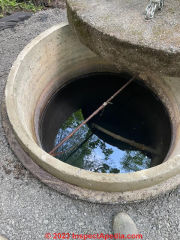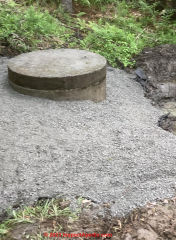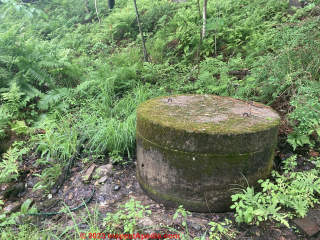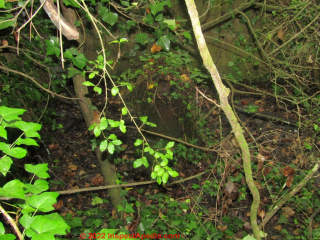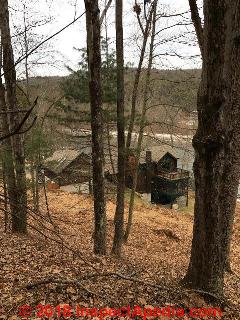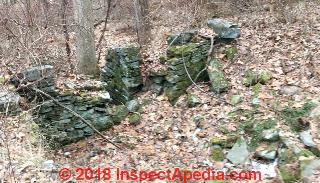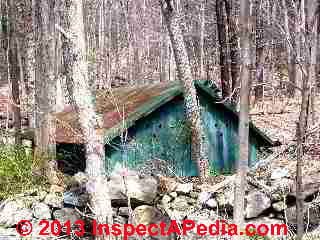 WaterSpring Box Construction Q&A
WaterSpring Box Construction Q&A
FAQs on protective enclosures for spring water
- POST a QUESTION or COMMENT about using springwater for drinking water
Spring water protective enclosure questions & answers:
FAQs on drinking water spring-box construction, repair, history, & use.
Questions & answers about how to build or repair a spring box or structure to protect spring water sources for drinking water.
Our page top photo illustrates a large protective structure over a drinking water spring.
This article series describes using springs for drinking water and explains issues with spring water sanitation. We provide advice about what to do when things go wrong with a drinking water spring, and we discuss the differences between a spring and a seep, spring and a dug well, and a spring and other types of water sources. .
InspectAPedia tolerates no conflicts of interest. We have no relationship with advertisers, products, or services discussed at this website.
- Daniel Friedman, Publisher/Editor/Author - See WHO ARE WE?
Drinking Water Spring Protection: Spring Box Construction & Repair FAQs
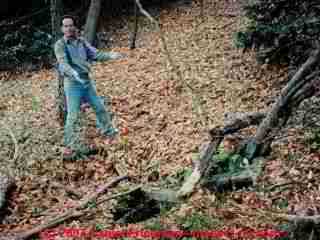 These questions & answers were posted originally
These questions & answers were posted originally
at SPRING BOX BUILD, REPAIR - be sure to review that article.
[Click to enlarge any image]
On 2023-06-16 by InspectApedia Publisher - consider running a pipe from near the top water level of the spring to a large water reservoir or stock watering tank downhill
@JkTmk,
In our discussion I don't see a spring water depth measurement, but
a round 5 ft. diameter spring "box" will hold about 19.6 gallons per foot of height (or depth) of water.
You say the spring is usually a gusher - at some unspecified gush rate in gpm or gph.
But that occasionally you run out of water or it stops delivering for a time.
Depending on the aquifer that feeds the spring, cleaning it or deepening it *might* improve its performance but from what you've said it sounds more valuable to me to consider running a pipe from near the top water level of the spring to a large water reservoir or stock watering tank downhill from the spring's location and near a point of use. Even if you had to pump from that tank to a watering trough that might give a storage buffer of a bit of extra water.
A cost-benefit analysis would want to consider the anticipated number of "dry spring" days, the daily water consumption, thus the volume of water reserve you'd need to get by, and the cost of building such a reservoir.
I'd add to that consideration that climate change and global warming could well mean that the usually great performance of this 100 year old spring may deteriorate sooner than we might have thought.
About cleaning the muck out of the bottom of the spring, your original post said that "the issue has become muck in the bottom" reaching the pump suspended in the spring.
Try cleaning out the muck with a sludge/mud pumping system often used to clean wells. Basically water is jetted to the bottom to loosen and stir up mud and muck that are then pumped out.
On 2023-06-16 by JkTmk
@InspectApedia Publisher, The interior tiles appear to be very clean. If I decide to muck out, do I need to totally drain the water?
It has been about one or two days in a few summers out of 13 years this spring stopped running, but recovered in 24 hours. Those summers were record droughts and we had more livestock/guests.
So I believe this has all the capacity we need now. I would like to find a way to capture this constant overflow and direct to livestock barn 300 feet downhill. 100 feet is thru the woods so that may be a challenge.
On 2023-06-16 by InspectApedia Publisher - use of concrete well rings was a good solution
@JkTmk,
Nice job!
And thank you so much for taking time to follow-up here. Your photo and discussion and example will be of help to other readers who are restoring a spring water source.
About mucking out the interior of your spring, now boxed in with concrete well rings, you might measure the usable depth of water and decide if, based on your rate of water use and the spring's measured flow rate, whether you need a larger standing or static water volume. From your earlier discussion it sounds as if that's not the case.
On 2023-06-15 by JkTmk
@InspectApedia-911, Phase One was finished today. Very pleased with the outcome. Basically I was looking to divert ground water away from the spring and prevent sediment from running into it.
We excavated mud from around the first tile out of ground, laid fabric around it and backfilled with sure pack gravel. The two swales had fabric and backfilled with gravel also. Ditching on a hillside with one water bar diverted that run off.
We removed the cover and found 4 ft tiles with 6 feet of water depth and 6-8 inches of muck. Water is running constantly out front in seam of top tile.
I may change the pump this fall, but as for mucking out, Im not sure that is worth the bother. The path to the area is now cleared and dry to get to the spring.
On 2023-06-13 by InspectApedia-911 (mod) - develop plan to avoid surface runoff entering the well
@JkTmk,
I certainly not smarter than an experienced on site excavator. However a basic point to consider is that what we don't want is surface runoff entering the well. So if adding that gravel is going to create that problem you may want to avoid it.
On 2023-06-13 by JkTmk
@InspectApedia Publisher, I have hired an excavator to divert some run off away from spring and to dig out the mud/settlement on the backside of pictured tile which is at base of a hill. He wants to replace that mud with gravel instead of stone for better packing against well tile.
Im guessing this is a bottom feeding spring, but if it is coming from the back side hill, could this disturb the water supply? I want to do this correctly before removing muck from interior because I feel it would fill back up again if the surrounding area is not corrected.
On 2023-06-08 by InspectApedia Publisher
@JkTmk,
Got it. Thanks for the photo.
Don't work alone.
Keep me posted, and post photos of the spring interior and of the cleanup. That would be helpful to other readers.
On 2023-06-08 by JkTmk - Jericho, VT spring box is difficult to access
@InspectApedia Publisher, It is located in Jericho Vt. Easy to drive equipment as close to 30 ft access path, which is very wet with downhill grade unaccessible to vehicles/tractors, possibly some excavators could navigate.
As far as I can tell, it is 3 tiles deep, one above ground, see pic, one below ground holding water, and one buried in muck. Thanks for the link, Ill give that a try. Drilling a well here is quite a crap shoot and very expensive.
On 2023-06-07 by InspectApedia Publisher - best way to get the muck out of the bottom of my spring box
@JkTmk,
Thanks for a helpful spring box maintenance question.
A combination of excavation or actual shoveling if you can do so safely (how deep is the well box?) and/or vigorous pumping using a trash pump can "suck" muck and mud out of a spring box much as we do when cleaning an old dug-well.
See our detailed suggestions in the section titled "Dug Well Cleaning & Disinfection Resources" in our article
HAND DUG WELLS
where you'll see a selection of free PDF downloads that give very detailed dug well cleaning and restoration procedures that can help clean out the spring box you describe.
Around the spring box you'll want to add rock and fix grading around the spring to keep surface runoff away - else you're adding contaminants to your spring water.
About the spring box cover: yes 500 lbs sure sounds like over-kill and is so heavy as to make access for inspection and cleaning a chore.
But
Watch out: your replacement cover must be child safe lest a curious kid - as I sure was and did - open the spring and crawl or fall inside.
You might construct a mechanically-secured steel cover with a hinged access door that can be locked.
Please, if you can, post some photos, one per comment, of your spring so that we can see what's going-on.
And tell me the country and city of location for this spring.
On 2023-06-07 by JkTmk
I have been using a 100 year old spring for 15 years quite successfully. It was modified 40 years ago with 5 ft diameter concrete tiles and a 1/2 hp well pump, replaced 25 yrs ago. Issue has become muck in the bottom so that pump that was hanging from bottom is now touching the bottom/muck.
The spring is a gusher, runs constantly outside tiles, producing small pond downstream.
Question, best way to de muck the bottom without disturbing the rock and possibly replacing older pump. Ground water may be seeping in as land has now eroded to grade slanting in, not away from spring. Also, cover is very heavy, 500 lbs plus. Could I replace with wood or metal for better access?
On 2022-10-13 by InspectApedia-911 (mod)
@Susana,
To improve your chances of contact you might want to spell out WNC
On 2022-10-10 by Susana
I have been on a natural spring box for home use for 20 years plus prior owner. Recently a tree fell down and diverted the spring away from box. I need to find a specialist in WNC pkease
On 2022-09-01 by InspectApedia-911 (mod) - how can I get rid of or hide old spring box
@Delicia,
You can, in most circumstances, remove the spring house, clean up debris and trash, and then direct the spring's output to an acceptable location such as a stream or pond.
By filling in the basin formed by the spring house you can in essence convert a springbox or spring house and spring to a small aboveground stream or brook.
On 2022-09-01 by Delicia
I have an old spring on my property that is no longer producing and is contaminated but it is Giant and ugly any suggestions on how to either get rid of it or hide it?
On 2022-07-19 by InspectApedia-911 (mod) - when you need to sanitize the spring box
@Alden Grout,
When you need to sanitize the spring box, which might make sense, you need to reach an adequate concentration of household bleach in the water and it needs to be there for a sufficient time. The details on how to calculate that based on the water volume in the Springhouse can be found at
inspectapedia.com/water/Well_Chlorination_Shocking_Procedure.php
On 2022-07-19 by Alden Grout
We have an old spring house that had the roof fall in, we cleaned all of the debris, mud etc out. Water quality and smell seems better. Our question is now that it is clean should we put some clorox in the spring house and run it through the system and to the house for a while?
On 2022-07-18 by InspectApedia-911 (mod) - cleaning and restoring a spring box
@roz henderson,
In cleaning and restoring a spring box, the order of business is first to be sure that the box is properly constructed and not damaged nor leaking. Details of how to do that are above on this page
Once you know that the container or spring box itself is intact and in good condition, then you need to remove debris from the interior of the spring box.
That might be scooping out branches and leaves for example if the Box didn't previously have a good roof.
In order to offer more specific spring box cleaning and disinfecting advice, we need to know more about your particular spring enclosure, how it is constructed, its dimensions, water quality and in flow rate, and what sort of sediment or debris you are trying to remove.
On 2022-07-18 by roz henderson
need information on cleaning spring
On 2022-06-23 by InspectApedia-911 (mod) - historic spring boxes
@Carter Finch,
From the shape we could certainly be seeing a spring box;
I can't make out where the pipes are mounted, nor direction. Perhaps you could post a sketch of what you're seeing.
If indeed there's a vertical pipe extending down 6-15 ft., then someone might also have driven a driven-point-well pipe into the same spot where there was a spring and spring box.
On 2022-06-23 by Carter Finch
I work for a history and archaeology firm in Georgia and we are researching a site below a small dam and adjacent to a stream with two assumed to be historic spring boxes (photos attached).
They are mostly covered with english ivy and no longer contain water. One has a concrete pipe sticking up from the ground, vertically in the center. The pipe is about 1 ft in diameter, maybe a little less.
Could this have been to reach deeper spring water, or used for overflow? I will attach a photo of the box here and another photo with the pipe which is hardly visible in the center of the photo.
On 2021-08-07 by inspectapedia.com.moderator
@WONGALPHONSIUS
You can do that.
On 2021-08-07 by WONGALPHONSIUS
hello
i wish to ask if it is right to directly pump water to a tank found above the spring box.if possible can one use a submersible pump foe that?
On 2021-07-11 by inspectapedia.com.moderator - Identify the components of this spring box
RE-posting from private email:
Identify the components of this spring box and give us advice on this spring as a water source.
On 2018-05-22 by (mod) - stones don't filter out bacterial nor chemical contaminants - warnings about roadside spring water
Stones can help filter some debris but of course don't filter bacterial contamination and might support it in some cases
I don't know enough about "ribbon or ball media" but am doubtful that any media placed in the spring can make its water safely potable.
These authors
- Lisle, John T., and Joan B. Rose. "Gene exchange in drinking water and biofilms by natural transformation." Water Science and Technology 31, no. 5-6 (1995): 41-46.
addressed stones and biofilms in springwater
Potability of spring water is addressed in this InspectApedia article series along with practical advice. YOu might want to see this research not about spring boxes but about spring water potability - the focus of your question
- Lamka, Karla G., Mark W. LeChevallier, and Ramon J. Seidler. "Bacterial contamination of drinking water supplies in a modern rural neighborhood." Applied and Environmental Microbiology 39, no. 4 (1980): 734-738.
- Thirunavukkarasu, O. S., T. Viraraghavan, and K. S. Subramanian. "Arsenic removal from drinking water using iron oxide-coated sand." Water, air, and soil pollution 142, no. 1-4 (2003): 95-111.
- Stevens, Alan A., Clois J. Slocum, Dennis R. Seeger, and Gordon G. Robeck. "Chlorination of organics in drinking water." Journal (American Water Works Association) (1976): 615-620.
As an aside, roadside springs appear to be at extra risk of contamination:
Several states in the U.S. issue general warnings about spring water.
- https://www.health.ny.gov/environmental/water/drinking/springs.htm is a NYS warning about roadside springs
- https://extension.psu.edu/roadside-springs is a Penn State warning also about roadside springs
- http://www.caes.uga.edu/newswire/story.html?storyid=5729&story=Safe-Drinking-Water warns about roadside springs in Georgia
On 2018-05-22 by Jera Anderson
I've read on multiple occasions where stones or other materials are use within spring boxes as initial filter media capturing sediment as well as hosting beneficial bacteria.
The bacteria aspect was more applicable in closed loop systems such as Kou ponds and the like. What would be your opinion on using ribbon or ball type media in a potable spring water application?
On 2018-03-28 by Chris
I have to repair the water feed from my springbox. Is there any way to prevent the water in it from escaping while L make the repairs? Thank you.
On 2018-02-21 by Anonymous
Thank you so much !!
I will keep watching and reading :)
k
On 2018-02-20 by (mod) -
A lot depends on estimated age and the location of the property.
I've seen old spring houses that had a room for a pump - as early as the late 1800's in some areas of North America.
In the UK I would check in with HistoricEngland.org.uk/advice who have a nice PDF on types of stone farm buildings in the UK
I wouldn't expect a rectangular multi-room stone building specifically intended as storage for grain at a typical small New England farm.
The small stone structure I illustrate below is a root store from National Farm Building Types, a nice PDF available from historicengland.org
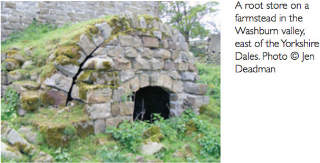
On 2018-02-20 by Anonymous
Thank you Dan! oh then.. I wonder what they are? Seems too small for an animal pen - and also.. the exit (hard to see in the pic) is only 2 ft. wide.. would that be large enough for a pig or another animal to exit? Could they be storage for corn?
On 2018-02-20 by (mod) - is this old stone foundation a spring box?
 Thank you for the photos, Karen.
Thank you for the photos, Karen.
By its location, uphill from other buildings, that's a good spot for a spring-fed spring-box water source.
However in your other photos the complexity of the foundation suggests that this was more than or other than a simple rectangle spring-box.
Also I don't see any remains of cement or plaster that typically would line a water-tight structure.
Incidentally the stone-work is a bit unusual: stones appear somewhat stacked in vertical columns - not a strong design.
Experienced stonemasons usually took care to stagger the vertical joints among courses of stone in walls.
On occasion we'll find remains of old iron pipes at an abandoned spring box, at an inlet point or a down-slope outlet point of the structure.
On 2018-02-20 by karen kourtessis
This is the terrain around it - I dont have a pic with the structures in the terrain.. but they are off to the right of this pic - next to a small stream - the road we live on has 3 or 4 culverts.. so there is a lot of water coming down toward the river.
This shot shows (b) the exit or door - the other 2 sides of the box have fallen in... mostly..
On 2018-02-20 by (mod) -
Karen
You're welcome to use the rectangular picture icon to the right of the comments button to attach some still photos of the Slate foundations that you found. We'll be glad to take a look. A photo of a more distant perspective showing the location and terrain would also be helpful.
On 2018-02-20 by karen kourtessis
I found 2 slate foundations on my property on a steep hill leading to the Delaware river in PA.
One of the foundations is about 60 ft above the other one. They are both near a small stream. They both have a small exit about 2 ft. wide. From all the research Ive done they seem to be spring boxes - Im wondering if these sound like spring boxes.. i have a video I can send.
On 2017-09-11 by (mod) -
Kitty,
I would like to see some sharp photos of the spring box outside, interior, and the piping in the box and leaving it. Use the page top or bottom CONTACT link to find our email.
I speculate that we could install a float-type valve (like those old ball float toilet tank control valves) that would simply shut off the piping when water level in the spring falls to a certain point.
That should work provided there are no air leaks in the piping.
On 2017-09-11 by Kitty
Hi there, we have a weird situation in our recently purchased home that is spring fed. The spring itself is located underground, and is inaccessible to us at this time. Every few days or so, air gets trapped in the line that empties into the cistern and the flow goes down to a trickle.
Often we won't catch it before we use up all the water in the cistern and the home will be without water until we fix the issue.
The issue can be fixed by using the garden hose, connecting it to the end of the line in the cistern, and pushing the air to break it up.
This gets the line flowing normally again, and once the water level covers the immersible pump, water kicks back on and all is normal. (we have to re-pressurize the tank under the house every time this happens too in order to avoid the water cutting in and out during use). So as you can imagine, very annoying.
I am just wondering, is there something like a valve we can install to fix this issue? Something that releases the air trapped or something that continually siphons air out? Thanks!
On 2017-08-22 by (mod) - spring water leaves turquoise residue on sinks bathtub clothes
Maggie,
A turquoise residue is most-often from high copper or copper deposits in the water, though I *speculate* that corrosive or aggressive water (not common with spring water) might also leach copper out of a plumbing system and do the same thing.
Please take a look at
WATER STAINING CONTAMINANTS - https://inspectapedia.com/water/Water_Staining_Contaminants.php
and
CORROSIVITY or ACIDITY of WATER https://inspectapedia.com/plumbing/Acidic_Corrosive_Water.php
Frankly with spring water as a drinking water source in most places in the world (as you don't give country, state or province or city) I'd be worried that just about anything that is on the ground surface, pesticides, for example, can easily enter the drinking water supply. That would be a reason to discuss with your lab what range of tests are appropriate for water sources in your area.
IF - since I can't possibly know from just an e-text - your water were high in copper, the most-common health effect is a gastrointestinal problem.
- Pizarro, Fernando, Manuel Olivares, Ricardo Uauy, Patricia Contreras, Adriana Rebelo, and Virginia Gidi. "Acute gastrointestinal effects of graded levels of copper in drinking water." Environmental Health Perspectives 107, no. 2 (1999): 117.
- Pizarro, Fernando, Manuel Olivares, Virginia Gidi, and Magdalena Araya. "The gastrointestinal tract and acute effects of copper in drinking water and beverages." Reviews on environmental health 14, no. 4 (1999): 231-238.
Arsenic occurs in drinking water in some locales - and can be carcinogenic, so that's another question to discuss with your water test lab.
- Smith, Allan H., Claudia Hopenhayn-Rich, Michael N. Bates, Helen M. Goeden, Irva Hertz-Picciotto, Heather M. Duggan, Rose Wood, Michael J. Kosnett, and Martyn T. Smith. "Cancer risks from arsenic in drinking water." Environmental health perspectives 97 (1992): 259.
Frankly, ANY claim that drinking water is causing ANY health concern, much less such a wide range as those you cite (that are not usually associated with a single common cause) are speculative until you know the key "poison" factors: dose and level (or duration) of exposure.
You should take these health concerns first to your personal physician.
PK88 about a "cistern"
I'm not sure what we're discussing.
A "cistern" in my definition is a closed container used to store water. That water has to come from some external source like rainwater collection, water delivery tanks, perhaps a nearby well or spring piped to drain into the cistern.
See CISTERNS, WATER STORAGE https://inspectapedia.com/water/Cisterns_for_Water_Storage.php
A dug well might be my description of what you might be discussing: a dug out hole in the ground into which groundwater enters from surrounding soil and/or rock.
See DUG WELLS, by HAND - https://inspectapedia.com/water/Hand_Dug_Wells.php
That dug -wells article series includes a discussion of things people do to try to restore water flow into the well: excavation, side probing, or as Paul Galow's dad did on their Pennsylvania farm, dynamite (I don't recommend the last item)
On 2017-08-22 by Maggie
I am supplied spring water from a mountain spring. It leaves a turquoise residue on sinks bathtub clothes. Is it safe to b drinking. Neighbors have incl me, cancer strokes brain tumors, breast cancer. Is it the water? Even heart problems.
On 2017-01-24 by pk88@juno.com
We share a cistern with another home on our street in Vermont. Both of our homes are 2nd homes. Our neighbors had a very old toilet that apparently ran continuously for a week and drained our spring's cistern dry. It has yet to recover.
I. Wondering if it could be struggling to refill because the temps have been below freezing. Is there anything that can be done to assist in its recovery?
This has been an active spring for over 50 years supplying these two houses as well as a third full timer ( they dug a well for their water after a drought 3 + years ago ) the spring bounced back from the summer drought and has been fine till now. Any suggestions appreciated. Thanks
On 2017-01-24 by Tricia. pl88@
We share a cistern with another home on our street in Vermont. Both of our homes are 2nd homes.
Our neighbors had a very old toilet that apparently ran continuously for a week and drained our spring's cistern dry. It has yet to recover. I. Wondering if it could be struggling to refill because the temps have been below freezing. Is there anything that can be done to assist in its recovery?
This has been an active spring for over 50 years supplying these two houses as well as a third full timer ( they dug a well for their water after a drought 3 + years ago ) the spring bounced back from the summer drought and has been fine till now. Any suggestions appreciated. Thanks
On 2017-01-13 by (mod) - teach me how to build a spring box
MJ,
Besides the article above and references cited in the REFERENCES section, spring boxes are discussed in quite a few articles that help the builder understand the objective: keeping surface contaminants out of the spring source and possibly accumulating a resevoir of spring water.
But I've not found a school, course, or class.
keep in mind that in the current world environment you can not assume that your spring water will be sanitary and potable - spring box or not
More scholarly research on spring box construction methods that's worth reading is given
at SPRING BOX CONSTRUCTION RESEARCH
On 2017-01-12 by MJ
I am moving to a property that has a spring running through a corner of the property.
I read about building spring boxes to preserve the water source as a back up plan. I have read articles but still think I'd rather have someone teache me the mechanics of building/installing one so I don't mess it up and waste time/money. Do you know of any place/organization that teaches self-sustainability skills for things like this?
On 2016-09-05 by jim
I have an old spring at my camp which is leaking at the base of the spring wall. Would clay be an appropriate medium to use to try to stop the leak or is there something else that would work better.
I have used concrete in the past but the water keeps finding its way through.
On 2016-07-21 by (mod) - how to restore a spring box
Ashley,
Clean all of the debris and crud from the spring box interior;
Inspect the spring box for leaks out or for surface water leaks in and fix those;
You may be able to deepen the box interior.
Then test your water for potability.
On 2016-07-20 by Ashley
We have a natural spring already has a box but has been unused for several years we just bought the land and want to fix it and make it work again properly its full of yucky stuff and we wanna dig it deeper and need to know what we can do to fix it our self
On 2016-05-13 by (mod) - Is there a way to "frack" the silt out of the surrounding area of the box without completely digging it up? I
Hey Walter, good question. You can try working with a wrecking bar around the spring box, or you could excavate to remove silt, filling in around the spring box walls with clean gravel. Keep in mind that if the water table is dropping no amount of gravel is going to raise it back up;
On 2016-05-1 y Walter
I have a spring box with four feed holes under the water level - I want to restore the volume output which has rerduced to a trickle to re-fill a restored pond.
Is there a way to "frack" the silt out of the surrounding area of the box without completely digging it up? It used to run 3 GPM continuously.
On 2015-09-05 by Janice C Retherford
Can you recommend a contractor to build a reservoir system in the Florence, Alabama area.
We have spring fed water in our home, however, the reservoir has collapsed. It was built by my husband's father in the 60s and is a very basic open system which stays filled with debris. We don't know anything about this type of thing and don't want to attempt it ourselves. Thank you for any help and advice.
On 2015-08-10 by (mod) - Is there something I can buy at lows to sprinkle on the ground to disinfect my spring water
Gail
No sprinkle-on-ground disinfectant would provide safe protection for a spring as water source and depending on the chemical concentration might make it unsafe.
At the More Reading suggestion above take a look at the article SPRINGS AS WATER SUPPLY to see more suggestions
On 2015-08-10 by gail mckee
there has been a well on this property since my grandparents moved here in 1973 it sits higher then the ground around it it has a concrete top and concrete 4in cylinder that stands above ground. we have about 3 or4 natural springs on a 4 acer property that run down and then level out
I have not looked inside but I do know that the water running into or around it are springs. we have run off points from the well that used to have a gravity pipe from it some how it dissaperd and know there is poddles of nasty mosey water about 6ft from the well site.
the thing is we have had more rain then useale and the other springs are starting to flow twords the well and it isn't going itnto the well its standinning water getting closer to surrounding the well . I believe it is a case of sabotage and I would like to tryb and fix this issue but don't have a clue.
I have made streams that are leading the standing water away but yhe springs produce a lot of water and I don't want them to get contaminated.
Is there something I can buy at lows to sprinkle on the ground while I am taking car of this issue. gail McKee liagrepeels@gmail.com
...
Continue reading at SPRING BOX BUILD, REPAIR or select a topic from the closely-related articles below, or see the complete ARTICLE INDEX .
Or see these
Recommended Articles
- BACTERIA LEVELS in WATER, INTERPRETATION
- SPRINGS as WATER SUPPLY
- SPRING BOX CONSTRUCTION
- SPRING BOX REPAIR
- SPRING YIELD IMPROVEMENT
- WATER QUALITY TESTS, CONTAMINANTS, TREATMENT
- WATER TESTING GUIDE
- WATER TREATMENT EQUIPMENT CHOICES - home
- WELLS CISTERNS & SPRINGS - home
Suggested citation for this web page
SPRING BOX CONSTRUCTION FAQs at InspectApedia.com - online encyclopedia of building & environmental inspection, testing, diagnosis, repair, & problem prevention advice.
Or see this
INDEX to RELATED ARTICLES: ARTICLE INDEX to WATER SUPPLY, PUMPS TANKS WELLS & SPRINGS
Or use the SEARCH BOX found below to Ask a Question or Search InspectApedia
Ask a Question or Search InspectApedia
Try the search box just below, or if you prefer, post a question or comment in the Comments box below and we will respond promptly.
Search the InspectApedia website
Note: appearance of your Comment below may be delayed: if your comment contains an image, photograph, web link, or text that looks to the software as if it might be a web link, your posting will appear after it has been approved by a moderator. Apologies for the delay.
Only one image can be added per comment but you can post as many comments, and therefore images, as you like.
You will not receive a notification when a response to your question has been posted.
Please bookmark this page to make it easy for you to check back for our response.
IF above you see "Comment Form is loading comments..." then COMMENT BOX - countable.ca / bawkbox.com IS NOT WORKING.
In any case you are welcome to send an email directly to us at InspectApedia.com at editor@inspectApedia.com
We'll reply to you directly. Please help us help you by noting, in your email, the URL of the InspectApedia page where you wanted to comment.
Citations & References
In addition to any citations in the article above, a full list is available on request.
- In addition to citations & references found in this article, see the research citations given at the end of the related articles found at our suggested
CONTINUE READING or RECOMMENDED ARTICLES.
- Carson, Dunlop & Associates Ltd., 120 Carlton Street Suite 407, Toronto ON M5A 4K2. Tel: (416) 964-9415 1-800-268-7070 Email: info@carsondunlop.com. Alan Carson is a past president of ASHI, the American Society of Home Inspectors.
Thanks to Alan Carson and Bob Dunlop, for permission for InspectAPedia to use text excerpts from The HOME REFERENCE BOOK - the Encyclopedia of Homes and to use illustrations from The ILLUSTRATED HOME .
Carson Dunlop Associates provides extensive home inspection education and report writing material. In gratitude we provide links to tsome Carson Dunlop Associates products and services.


